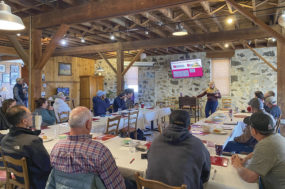This spring, the Department of Water Resources changed the “methodology” or process they use to estimate water shortfalls and determine curtailments. This year, the new methodology predicts a 75,200 acre-foot shortfall to the Twin Falls Canal Company (TFCC). In such a wet year, that prediction has come as a surprise. But the biggest surprise has been the department’s response to it. The department has decreed that, in the absence of a mitigation plan, 700,000 acres (about 1,100 square miles) of groundwater-irrigated land must be curtailed (i.e., dried up).
Such a curtailment is predicted to erase about $600 million in annual household income from eastern Idaho. There are alternatives to curtailment (referred to as “mitigation”), but because they require the purchase and delivery of excess surface water, they are only viable in years when water is relatively plentiful. In drier years – the very times when we most need protection from curtailment – mitigation offers little or no protection.
The disproportionate impacts of this order on groundwater pumpers in eastern Idaho is staggering. According to the department, groundwater pumpers, in the absence of mitigation, must shut off 1.6 to 1.8 million acre-feet of water to account for a 75,200 acre-foot injury to TFCC. And the new methodology ensures that future shortfall predictions and curtailment orders will be both more frequent and more severe. This places every acre within the Eastern Snake Plain Aquifer – along with adjacent industries, counties and cities – in constant jeopardy of widespread curtailment.
The department’s approach also ignores many of the laws and rules that govern water administration. IDAPA 37 (Idaho Administrative Procedures Act) recognizes that the state must approach “the administration and use of surface and groundwater in a manner consistent with the traditional policy of reasonable use of both surface and groundwater.” To that end, the rules state that “an appropriator is not entitled to command the entirety of large volumes of water in a surface or groundwater source to support his appropriation contrary to the public policy of reasonable use of water.” The director is also to consider “whether the petitioner making the delivery call… is diverting and using water efficiently and without waste.”
Consider the following. Over the past several years, irrigators in the Bingham Ground Water District have diverted an average of 1.8 acre-feet per acre (af/ac) to water our crops. In contrast, the Twin Falls Canal Company diverts about 5.7 af/ac to irrigators with a similar crop mix. But the problem doesn’t lie with irrigators. The department estimates TFCC’s efficiency at 35%. That means that of the 5.7 af/ac diverted from the river, only about 2 af/ac actually reaches the farmers. When Magic Valley farmers say that they aren’t using more water than us and that they face pressure in dry years, they’re telling the truth. Their canals’ century-old systems are simply ill-equipped to get them the water they need in the driest years; 65% of the water diverted by TFCC never makes it to their patrons.
But the problem, at its core, doesn’t really lie with our canals, either. It lies with the state, whose policies encourage waste and penalize efficiency. The Department of Water Resources calculates canals’ water needs based on their current efficiency levels. This means that by becoming more efficient, TFCC would be voluntarily surrendering a portion of their water appropriation. This is why, when groundwater pumpers approached canal boards and offered to pay many millions of dollars to upgrade their canal systems, the offer was immediately declined.
The state cannot continue to administer water like this. It does not serve irrigators or communities on either side of this discussion. It places groundwater pumpers under the constant threat of curtailment and denies surface water users the kind of improved conveyance systems that could consistently and dependably deliver the water they need. Real solutions exist, but we will never achieve them if we continue to reward waste and discourage the efficient use of our precious water resources. The state’s current approach is both irresponsible and inconsistent with the principles of prior appropriation. A stable water future depends on a better approach.
Adam Young is a third-generation barley, wheat and alfalfa grower in Bingham County. His family operates 2,700 acres of irrigated farmland.
Publisher’s statement: “The opinions expressed are not necessarily those of the publishing company. Ag Proud – Idaho encourages reader comment (reasonable, respectful debate, devoid of mentioning names). Contrasting points of view from responsible individuals are welcome.”






